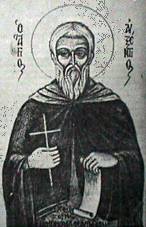 |
St. Auxentius' name day is the 28th September. |
After a visit to the holy city of Jerusalem they settled in the read of the Jordan river. However the conditions in the area were such that they could not fulfill their monastic life and they decided to leave for Cyprus. They boarded a ship which took them to Paphos, from where they traveled and settled in various monasteries or remote places of the island. Auxentius ended up in cave at the the base of the Penatdactylos mountain in the Karpas peninsula between the villages of Komi Kebir and Eptakomi. There he lived as a hermit and spent his time writing and praying to God till the his death. When the news of his death arrived, the inhabitants of both neighboring villages demanded the remains for burial. The dispute was resolved, following a suggestion by an old local man, in the following way: The body would be loaded on a carriage carried by one cow from Eptakomi and one cow from Komi Kebir. The animals will be let free to follow a route. The village they will choose will be the place where the holy remains will be buried. And indeed all agreed to this proposal. The mortal remains were placed on the carriage and the animals took it to Komi Kebir. There Auxentius was buried and a chapel was erected in his memory.
(Komi Kebir and Saint Auxentius church are inaccessible to its inhabitants since the Turkish invasion of 1974)
Copyright © 1998, Nostos.com. All rights reserved.